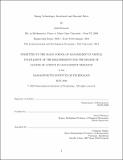Rising technologies, investment and discount rates
Author(s)
Dernaoui, Zaki.
Download1191221877-MIT.pdf (924.2Kb)
Other Contributors
Sloan School of Management.
Advisor
David Thesmar.
Terms of use
Metadata
Show full item recordAbstract
This paper examines the recent compositional shift in corporate capital and its impact on investment's sensitivity to funding costs. I show that the rising share of intangibles in U.S firms' assets significantly dampens the stimulus effect of interest rate shocks. For a given surprise change to the fed funds rate, a one standard deviation above the mean in intangible capital intensity mutes investment's response by more than 30%. These results hold in robust specifications, when isolating the pure interest rate effect, and controlling for other known factors such as leverage and firm growth. A number of characteristics of intangible capital can potentially explain the heterogeneous responses: collateral value, adjustment costs, project duration and de- preciation rates. I propose a structural interpretation of the empirical findings in a quantitative general equilibrium model of heterogeneous firms. Under a reasonable calibration, the model's insights indicate that the higher depreciation tax shield from intangible capital investment quantitatively plays the main role in driving the results. I present further empirical evidence for this channel by focusing on negative profit firms.
Description
Thesis: S.M. in Management Research, Massachusetts Institute of Technology, Sloan School of Management, May, 2020 Cataloged from the official PDF of thesis. Includes bibliographical references (pages 27-29).
Date issued
2020Department
Sloan School of ManagementPublisher
Massachusetts Institute of Technology
Keywords
Sloan School of Management.